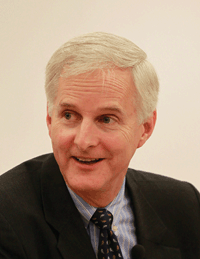New chief executive takes the helm of the Hong Kong carrier with a strong legacy and sights set on tapping China's growth
Ending your stint at the helm of a major global airline just after the company has posted record profits must feel good. Just ask Cathay Pacific's Tony Tyler, who leaves on 31 March after four years with the oneworld carrier reporting a near-tripling of full year net profits to HK$14.05 billion ($1.81 billion).
That, however, could be a double-edged sword for his successor as chief executive, the amiable America-born John Slosar. On the one hand, Tyler leaves a great base to build on. On the other, if things do not go so well, comparisons can be less than flattering.
 |
|---|
"We need to build up the Cathay team, identify the future management, inspire them to grow the business", John Slosar, incoming chief executive at Cathay Pacific |
Industry sources who have worked with him, and are familiar with both Cathay and Swire, say that he was quickly identified as having the potential for a senior management role. Along the way, he was managing director of Hong Kong Aircraft Engineering and ran Swire's Beverages Division, which includes the Coca Cola brand, becoming its chairman in July 2010.
CHINESE POTENTIAL
His stint as chief operations officer of Cathay since July 2007 has allowed him to get deep into the airline business, and those who have worked with him say that he loves getting stuck into the details. He is especially excited about the potential of the Chinese market, they add.
No surprise, then, that Slosar has identified increasing Cathay's presence in the mainland market, together with subsidiary Dragonair and partner Air China, as one of his four priorities when he takes over. The others are building up and marketing the Cathay brand more aggressively, ensuring that the airline recruits and retains talented staff, and growing the Hong Kong hub.
"These will ensure Cathay remains at the forefront of the airline industry," says Slosar. The Cathay brand, he adds, is a valuable asset that must continue to be grown. This includes everything the passengers "see, touch and interact" with - from the in-flight product and service, to the service at airports, and the website. Cathay's employees are crucial to this, he adds.
"We need to build up the Cathay team, identify the future management, inspire them to grow the business," he says.
Of vital importance is Hong Kong's role as a major passenger and cargo hub. "The more we make Hong Kong a fantastic place for people to come to and transit in, the better for us. We plan to have more flights to more destinations, more connections as a hub, and work with the airport we have everything that passengers need," he says.
PICKING UP CARGO
Hong Kong is the world's busiest cargo market, and Cathay is building its own cargo terminal at the airport and taking delivery of its first Boeing 747-8 Freighter this year. "There is a lot of competition from both Chinese and non-Chinese companies," he says. "But there is plenty of demand for cargo services in the region."
China, says Slosar, is "fantastically important". He believes that by 2020, when the industry looks back at this decade, the development of the Chinese market will be the biggest story.
"The international travel market to China is expanding rapidly. Everyone wants to travel to and from China. The challenge for all of us is to figure out how we take advantage of that. We must grow our network and offer the best connections," he says.
The airline will work closely with Beijing-based Air China, which has a 29.9% stake in Cathay, and subsidiary Dragonair, which provides most of the links to the mainland from Hong Kong, to tap into this.
Plenty of eyes will be on the relationship with the mainland's flag carrier Air China, in which Cathay itself has an 18% stake. The two appear to be like chalk and cheese. The Chinese carrier is publicly listed, but government-owned while Hong Kong-listed Cathay is privately owned; Air China is part of Star Alliance and Cathay in oneworld; and their work culture is different.
The two, however, work closely. Staff from both companies go on attachments, the carriers are constantly talking about how they can cooperate, and they are about to start up a new cargo joint venture based in Shanghai.
"It is interesting working with them and we think they like working with us. Internally, of course, there are differences in the way the airlines are run. But when we talk to them, we agree more than we disagree. The most important thing is that we respect each other and keep each other happy," says Slosar.
There is speculation that Air China may eventually want to have a bigger stake in Cathay, although that would depend on the Swire Group selling - something the conglomerate is not contemplating at the moment.
Slosar believes that the next five to seven years will define the relationship between the partners, and he adds: "We will see where we want to take this, whether it is in alliances or strategy."
Making that decision will be one of his biggest challenges.
Read departing Cathay chief Tony Tyler's reflections on 25 years of the airline business
Source: Airline Business
















